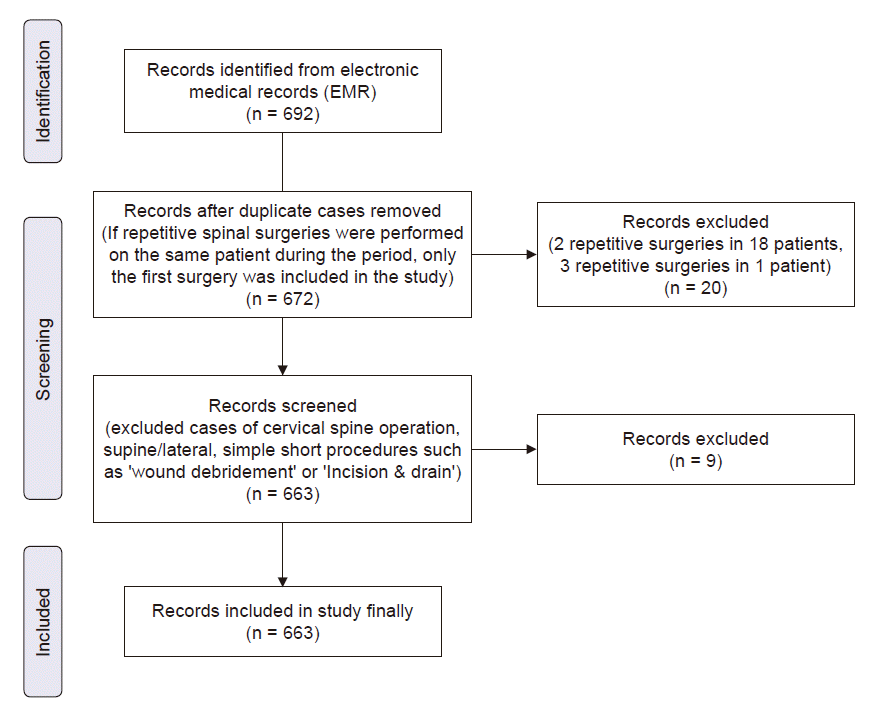1. Edsberg LE, Black JM, Goldberg M, McNichol L, Moore L, Sieggreen M. Revised National Pressure Ulcer Advisory Panel pressure injury staging system: revised pressure injury staging system. J Wound Ostomy Continence Nurs. 2016; 43:585–97.
2. Kim JM, Lee H, Ha T, Na S. Perioperative factors associated with pressure ulcer development after major surgery. Korean J Anesthesiol. 2018; 71:48–56.
3. Choi SJ, Kim DW, Chung HS, Ahn HJ, Gwak MS, Yang M, et al. The incidence rate and risk factors of pressure-induced skin breakdown during operation. Korean J Anesthesiol. 2006; 50:525–9.
4. Edlich RF, Winters KL, Woodard CR, Buschbacher RM, Long WB, Gebhart JH, et al. Pressure ulcer prevention. J Long Term Eff Med Implants. 2004; 14:285–304.
5. Nixon J, Cranny G, Bond S. Skin alterations of intact skin and risk factors associated with pressure ulcer development in surgical patients: a cohort study. Int J NursStud. 2007; 44:655–63.
6. Allman RM, Goode PS, Patrick MM, Burst N, Bartolucci AA. Pressure ulcer risk factors among hospitalized patients with activity limitation. JAMA. 1995; 273:865–70.
7. Munro CA. The development of a pressure ulcer risk-assessment scale for perioperative patients. AORN J. 2010; 92:272–87.
8. Peixoto CA, Ferreira MBG, Felix MMDS, Pires PDS, Barichello E, Barbosa MH. Risk assessment for perioperative pressure injuries. Rev Lat Am Enfermagem. 2019; 27:e3117.
9. Hwang HY, Shin YS, Cho HS, Yeo JS. Risk factors of pressure sore in patients undergoing general anesthesia. Korean J Anesthesiol. 2007; 53:79–84.
10. Jesurum J, Joseph K, Davis JM, Suki R. Balloons, beds, and breakdown. Effects of low-air loss therapy on the development of pressure ulcers in cardiovascular surgical patients with intra-aortic balloon pump support. Crit Care Nurs Clin North Am. 1996; 8:423–40.
11. O'Brien DD, Shanks AM, Talsma A, Brenner PS, Ramachandran SK. Intraoperative risk factors associated with postoperative pressure ulcers in critically ill patients: a retrospective observational study. Crit Care Med. 2014; 42:40–7.
12. Dharmavaram S, Jellish WS, Nockels RP, Shea J, Mehmood R, Ghanayem A, et al. Effect of prone positioning systems on hemodynamic and cardiac function during lumbar spine surgery: an echocardiographic study. Spine (Phila Pa 1976). 2006; 31:1388–93; discussion 1394.
13. Luo M, Long XH, Wu JL, Huang SZ, Zeng Y. Incidence and risk factors of pressure injuries in surgical spinal patients: a retrospective study. J Wound Ostomy Continence Nurs. 2019; 46:397–400.
14. Yoshimura M, Ohura N, Tanaka J, Ichimura S, Kasuya Y, Hotta O, et al. Soft silicone foam dressing is more effective than polyurethane film dressing for preventing intraoperatively acquired pressure ulcers in spinal surgery patients: the Border Operating room Spinal Surgery (BOSS) trial in Japan. Int Wound J. 2018; 15:188–97.
15. Wu T, Wang ST, Lin PC, Liu CL, Chao YF. Effects of using a high-density foam pad versus a viscoelastic polymer pad on the incidence of pressure ulcer development during spinal surgery. Biol Res Nurs. 2011; 13:419–24.
16. Saghaleini SH, Dehghan K, Shadvar K, Sanaie S, Mahmoodpoor A, Ostadi Z. Pressure ulcer and nutrition. Indian J Crit Care Med. 2018; 22:283–9.
17. Mistrík E, Dusilová-Sulková S, Bláha V, Sobotka L. Plasma albumin levels correlate with decreased microcirculation and the development of skin defects in hemodialyzed patients. Nutrition. 2010; 26:880–5.
18. Hicks DJ. An incidence study of pressure sores following surgery. ANA Clin Sess. 1970; 49–54.
19. Tschannen D, Bates O, Talsma A, Guo Y. Patient-specific and surgical characteristics in the development of pressure ulcers. Am J Crit Care. 2012; 21:116–25.
20. Lyder CH. Assessing risk and preventing pressure ulcers in patients with cancer. Semin Oncol Nurs. 2006; 22:178–84.
21. Ranzani OT, Simpson ES, Japiassú AM, Noritomi DT; Amil Critical Care Group. The challenge of predicting pressure ulcers in critically ill patients. A multicenter cohort study. Ann Am Thorac Soc. 2016; 13:1775–83.
22. Han Y, Jin Y, Jin T, Lee SM, Lee JY. Impact of pressure injuries on patient outcomes in a Korean hospital: a case-control study. J Wound Ostomy Continence Nurs. 2019; 46:194–200.




 PDF
PDF Citation
Citation Print
Print




 XML Download
XML Download